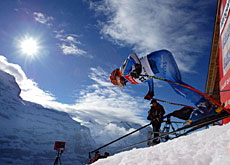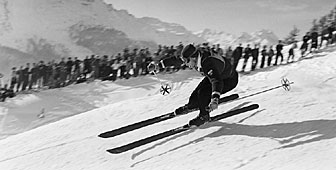Lauberhorn – more than a race

Swiss ski fans are in Lauberhorn fever this weekend as the legendary ski races get underway for the 73rd time.
More than just a race meeting, the Wengen event is now part of Swiss folklore and a welcome boost to the local economy.
“The Lauberhorn is very important to the whole region,” says Wengen tourism director Ursula Mühlemann.
“January is normally a very quiet month, but interest in the race generates around 30,000 extra overnight stays – not just in Wengen, but in the whole Lauterbrunnen region.
“When you total up the increase in revenue for the hotels, restaurants, souvenir shops and the local railway, you see a boost to the economy of some SFr7 million.”
This amount could even be topped this year as for the first time in it 73-year-old history the race will take place twice in a row.
The International Ski Federation, FIS, decided this on Wengen’s request – the local authorities claimed that costs were too high for only one race.
High interest
The race may be a financial godsend for the region’s businesses, but interest in the Lauberhorn stretches far beyond this small section of the Bernese Oberland.
Thousands of spectators travel to Wengen to watch the event live, while Swiss television coverage regularly attracts more than one million viewers, accounting for some 80 per cent of all television being watched in Switzerland during the course of the race.
The race’s continuing popularity has a lot to do with the stamina-sapping dimensions of the 4.2km Lauberhorn course – easily the longest piste on the World Cup circuit.
Its status as one of the original “classic races” also allows the Lauberhorn to preserve such challenging features as the Hundschopf (Dog rock) turn – a three-metre-wide corridor between two jutting rocks – and the Wasserstation tunnel where skiers have to duck under the local railway.
Rich history
But for many, the Lauberhorn’s present fame rests on the richness of its history.
Viktor Gertsch, president of the organising committee, knows that history better than anyone, having taken over the running of the race from his father Ernst Gertsch, one of the original founders of the event.
“Like all good ideas, I think the concept of the Lauberhorn was probably first formed at two o’clock in the morning in some local pub,” grins Viktor Gertsch.
“The original aim was to organise a competition against Switzerland’s neighbouring countries and particularly against the British officers who used to holiday here – to prove that the natives of Wengen were as good as the British sportsmen.”
In fact, they proved themselves a good deal better, with the skiers of Wengen and nearby Scheidegg winning 14 of the Lauberhorn’s first 15 editions.
War, what war?
Local dominance was certainly helped in those early years by Switzerland’s non-participation in the Second World War.
With the rest of Europe otherwise preoccupied, the race ran uninterrupted from 1939 to 1945, a period in which local legend Karl Molitor won four of his six Lauberhorn titles.
Now aged 82, Molitor remains a fantastic source of information for those wishing to relive the “good old days” of Switzerland’s greatest ski race.
“There’s really no comparison between the races of my time and the current form of skiing,” Molitor points out. “Nowadays they’re travelling at such unbelievable speeds and still all finishing with almost exactly the same times.
“I remember my first victory here in 1939, when I actually fell near the finish line but was still able to get up and finish nine seconds ahead of the runner-up. In those days you always had winning margins of at least a few seconds.
Generation gap
“The difference in the equipment is of course phenomenal – much more so than in tennis, for example, or football.
“I always think it would be great to see today’s skiers trying to get down the modern courses using the old-fashioned equipment, but it just wouldn’t be possible because today’s man-made pistes are so rock hard.”
Faced with such daunting “relics” as the Hundschopf turn or the Wasserstation tunnel, Molitor’s modern-day successors are unsurprisingly reticent about taking up the old man’s challenge.
“I’m really happy to be racing in the present day,” Switzerland’s top speed specialist Didier Cuche admitted to swissinfo after completing his first training run on Wednesday.
“It’s difficult for me even to imagine how they used to ski before. Without the course preparation that we have today, it must have taken a lot of strength and concentration, and I’m sure it was just as hard to win in those days, even if the winning margins make it look less competitive.”
Après-ski
While Molitor and Gertsch are both full of admiration for the breathtaking speeds and lightning reactions involved in the modern version of professional skiing, both believe that life was a lot more fun in their day, especially when it came to the “après-ski”.
“The evenings were always enjoyable,” recalls Molitor with a broad smile, “but the best of all was of course the Sunday dinner when all the competitors would stay on in Wengen for the prize-giving and the dancing – there were always lots of girls.
“Nowadays it seems the skiers have to leave for their next destination almost before they’ve crossed the finish line.
“Back then, though, we always had a very friendly time – although there wasn’t as much drinking as people might imagine, except maybe on those Sunday nights!”
Austrian celebrations
While Gertsch also remembers with fondness the “family atmosphere” of previous Lauberhorn races, he points out that some Sunday nights were less friendly than others.
“I remember in particular the 1969 weekend, when the Austrians as usual had won the slalom, the combined race and taken all three podium places in the Lauberhorn itself. After celebrating hard at the Palace Hotel, the team went over the road to the bowling alley and started bowling with the trophies.
“Well, the trophies were completely destroyed and of course we weren’t too happy about that. I guess they also showed they could beat us at bowling!”
Today the Austrians dominate the professional skiing scene in much the same way as they did in the 1960s, with Switzerland’s fiercest rivals clinching four of the last five Lauberhorn titles.
Having virtually monopolised the event during its first 15 years, the Swiss on the other hand have now gone nine years without victory on the hallowed piste.
That long wait, along with the usual excitement generated by the Lauberhorn, should at least help motivate Cuche and co as they set out to restore Swiss pride in the country’s favourite sporting event.
swissinfo, Mark Ledsom in Wengen
This year’s Lauberhorn meeting includes an extra downhill race to be run on Friday, with the “classic” event following on Saturday.
Friday’s race will be part of the combined event, in which points from the downhill are added to those won in Sunday’s slalom race.
The winner of each race will get a prize of SFr33,000.
One of the original “classic” ski races, the Lauberhorn was first staged in 1930.
The race is estimated to provide a boost of some SFr7 million for the region.
The last Swiss victory dates back to 1992, when Franz Heinzer took top honours.

In compliance with the JTI standards
More: SWI swissinfo.ch certified by the Journalism Trust Initiative











You can find an overview of ongoing debates with our journalists here . Please join us!
If you want to start a conversation about a topic raised in this article or want to report factual errors, email us at english@swissinfo.ch.